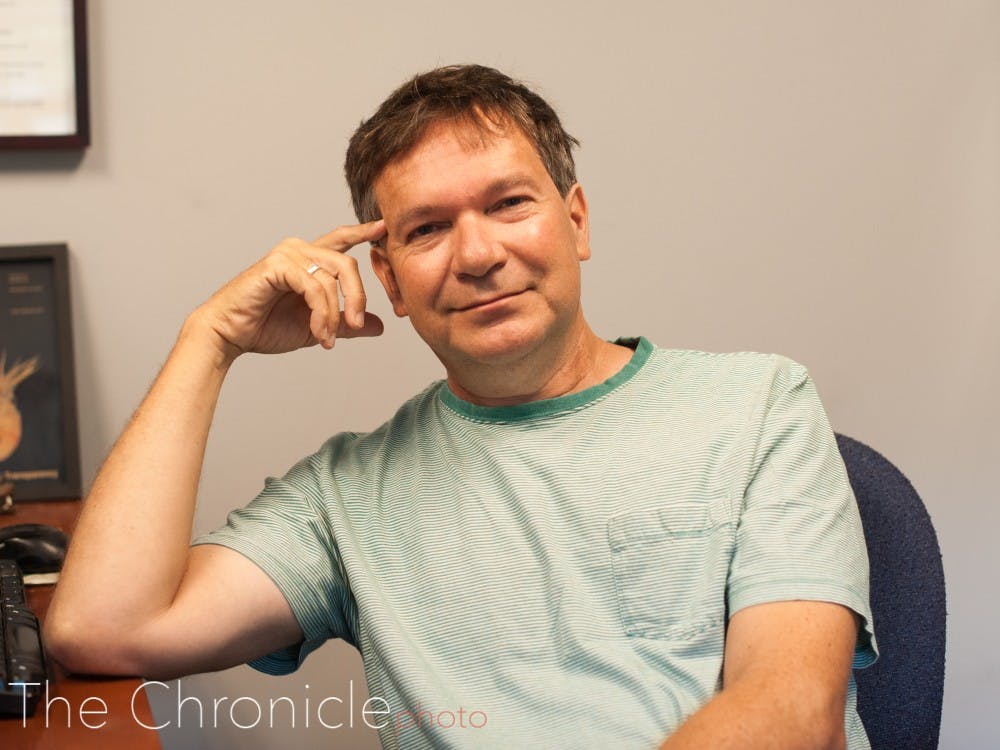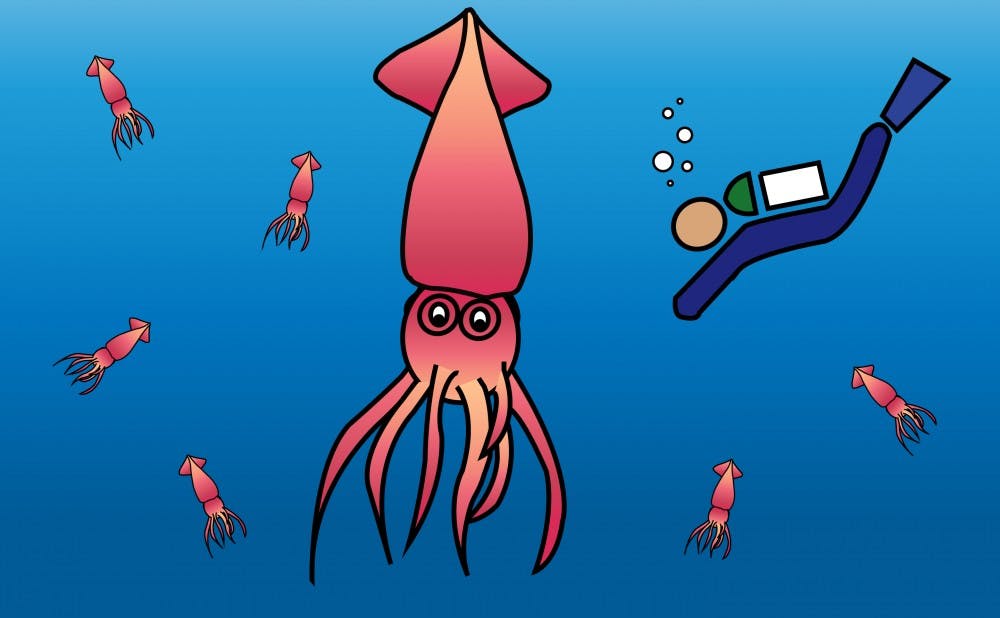As the saying goes, lightning rarely strikes the same place twice—but sometimes it strikes right after you see a giant squid.
While the saying might seem oddly specific, that was the reality of June 20 for one Duke professor—Sönke Johnsen, professor of biology at Duke, who became a biologist on a dare and wound up on research cruises searching for squids.
Johnsen, with a team of other researchers from around the country, led an eventful National Oceanic and Atmospheric Administration exploration cruise earlier this year that brought back the first footage of a giant squid in U.S. waters.
NOAA funding comes with a quirk, requiring that expeditions focus on exploring rather than testing any specific hypothesis. Exploration is one thing, but this mission to the Gulf of Mexico needed to bring in new techniques to actually find anything.
The Gulf of Mexico, in the grand scheme of bodies of water, is not particularly large or remote. In fact, Johnsen said, the flood of the Gulf at any given time is patrolled by a small army of more than 1,000 robot submarines, mostly run by large oil companies interested in maintaining their drilling operations. Given their mission, the robots are not particularly good at staying quiet or unobtrusive, making them poor scientists.
"They say that they never see anything and they have an incredible amount of footage showing that they never see anything," Johnsen said. "But deep sea animals are smart enough to just go away when anything is big and noisy."
The NOAA team, including Johnsen, knew that they needed to be as quiet and unremarkable as possible. To do so, they brought in the Medusa camera.
The Medusa, which was also used to capture the first video of a giant squid seven years ago, was developed by Johnsen with a couple of colleagues around 2009. Built on a modest budget, the camera is designed to give off as little light and noise as possible. Apart from a small LED array on the camera, it is nearly completely anonymous, dangling at the end of a mile of rope.
That rope has a satellite-tracked buoy on the other end that lets the researchers track their camera as it drifts for more than a day. Less conveniently, the rope has to be lowered and raised by hand, which can take more than three hours each way.
"It was like 19th century mariner days, telling jokes and anything else to keep ourselves entertained as we pulled it up hand-over-hand," Johnsen said.
Armed with a robotic submarine, a trawling net—the kind of fishing net that commercial fishing crews would use—and the Medusa camera, the team set out for weeks at sea. As it turned out, the squid was in more of a hurry than the expedition was.
"Amazingly, after only sending [the camera] down five times, we picked up a giant squid," Johnsen said.
The team hurried to the mess hall—the dining area of the ship—and huddled around the computer to watch the squid drift into view and grab the camera before backing off when it realized that it probably wasn't food. That's when lightning struck—literally.
"We see this huge column of yellow and gray smoke about 50 or 60 feet tall off the back of the ship," Johnsen said. "We look back at the ship and we see that the entire mast is gone."
While no one was hurt, the lightning strike cost the ship its communication equipment, which they needed in order to get in touch with experts and confirm that they really had spotted a giant squid. When they eventually got through, they got their confirmation.
The next step was getting in touch with a reporter at a national newspaper, no easy feat for a small group of scientists in the Gulf of Mexico claiming to have just recorded video of a giant squid. As Johnsen pointed out, it's a difficult story to get picked up out of the blue, similar to emailing a newspaper with your most recent picture of a UFO.
"If you go on the web portal for the New York Times and type that you've just seen a giant squid, nobody writes back," Johnsen said.
Eventually, they were put in touch with a contact at the New York Times. Days later, the story was out, bringing unusual attention to the world of ocean biology research cruises, with Johnsen at the center.
Johnsen and another researcher on the research cruise also documented the research cruise's events in the team's mission log, which is available to the public on NOAA's website.
'B for biology'

While the squid-hunting research cruise was a giant accomplishment, Johnsen's career path up to now has been far from smooth sailing.
The son of a physicist and a doctor, Johnsen's path to biology was improbable. It seemed even less likely in the 1980s, when he enrolled at Swarthmore College—a small liberal arts college in the Philadelphia suburbs—to study physics. The choice of college was not driven by any particular drive to pursue a science career at a liberal arts school, but rather by Swarthmore College's proximity to a family friend's hardware store.
The physics dream was short-lived, as Johnsen jumped ship to the math department, inspired by a particularly colorful algebra professor and an aversion to what he calls the dry world of physics. At Swarthmore, Johnsen also dabbled in art and dance, knowing that he wasn't interested in becoming a mathematician.
"I left having no idea what I wanted to do with myself," Johnsen said.
After graduation, with little idea of what he wanted to do, Johnsen made the obvious choice—he hopped on a plane to the West Coast and spent time hitchhiking along the Pacific. Along the way, he took time to set up a daycare center, and he taught kindergarten and first grade.
Johnsen also dabbled in careers more aligned with his math background, spending time as an assistant to Stuart Kauffman, a theoretical biologist whose research focused on complex systems related to the origins of life on earth. Kauffman has also had a taste of scientific stardom, cited by novelist Michael Crichton as one of the scientific sources for “The Lost World,” the sequel to “Jurassic Park.”
Eventually he decided to come back home, or at least his college roots, and returned to the Philadelphia area as a carpenter.
After one particularly bad day of carpentry, Johnsen and his friend had had enough. In the car back from the failed job, they decided that they needed to sort out their futures. True to Johnsen's career, they went about it in a fairly unorthodox way.
"We each went through the alphabet and I stopped at B for biology for no good reason," Johnsen said. "We literally dared each other to go to graduate school in a subject from the alphabet."
A dare is a dare, so Johnsen pulled together an application for biology graduate programs and sent it out to three schools—Duke, University of North Carolina at Chapel Hill and the University of Chicago. He never expected to hear back from any of them, but they came calling anyway.
Now faced with a choice between three schools that he had assumed would laugh at his application, Johnsen passed on Duke for the other end of Tobacco Road.
Even without actual biology experience, the admissions committee was interested in bringing Johnsen in—as he tells it, they thought that it would be easier to teach a physicist biology than to teach a biologist physics. Once he was in, it was another story. At their initial meeting, his first faculty committee was skeptical, to say the least.
"It wasn't until they had admitted me that they suddenly realized that they'd made a mistake," Johnsen said.
That skepticism wasn't nearly enough to deter a sort of physicist, sort of kindergarten teacher, sort of carpenter dead set on making it work in biology. The first couple of years were a grind, sustained by Johnsen's ability to draw bugs better than most biologists, most of whom had shockingly limited art experience.
As he grew more comfortable in biology, he started branching out and seeking more out-of-the-box opportunities, until he stepped foot on a research cruise.
"Every part of it was amazing, and in many ways pretty miserable," Johnsen remembered.
Since then, Johnsen's career has turned markedly more conventional. Johnsen received his doctorate in biology from UNC-Chapel Hill in 1996. He has been teaching at Duke since 2001, ran the graduate school's biology admissions program for eight admissions cycles and lives nearby with his family.
When he returned to Duke, the consistency was remarkable for Johnsen, who found a situation much like the one he had gotten used to in graduate school, when he took many of his classes at Duke.
"I still had the same library fines from when I was a student," Johnsen said.
His career appeared conventional, with the obvious exception of taking somewhere between two and six weeks a year to venture out onto the open waters to find whatever there is to find.
After all of those twists and turns, Johnsen is reluctant to recommend his path to students in 2019. That being said, he still emphasizes that knowing exactly what you want to do out of school is both rare and unnecessary.
"I loved every moment, all the way through," Johnsen said.
Get The Chronicle straight to your inbox
Signup for our weekly newsletter. Cancel at any time.

